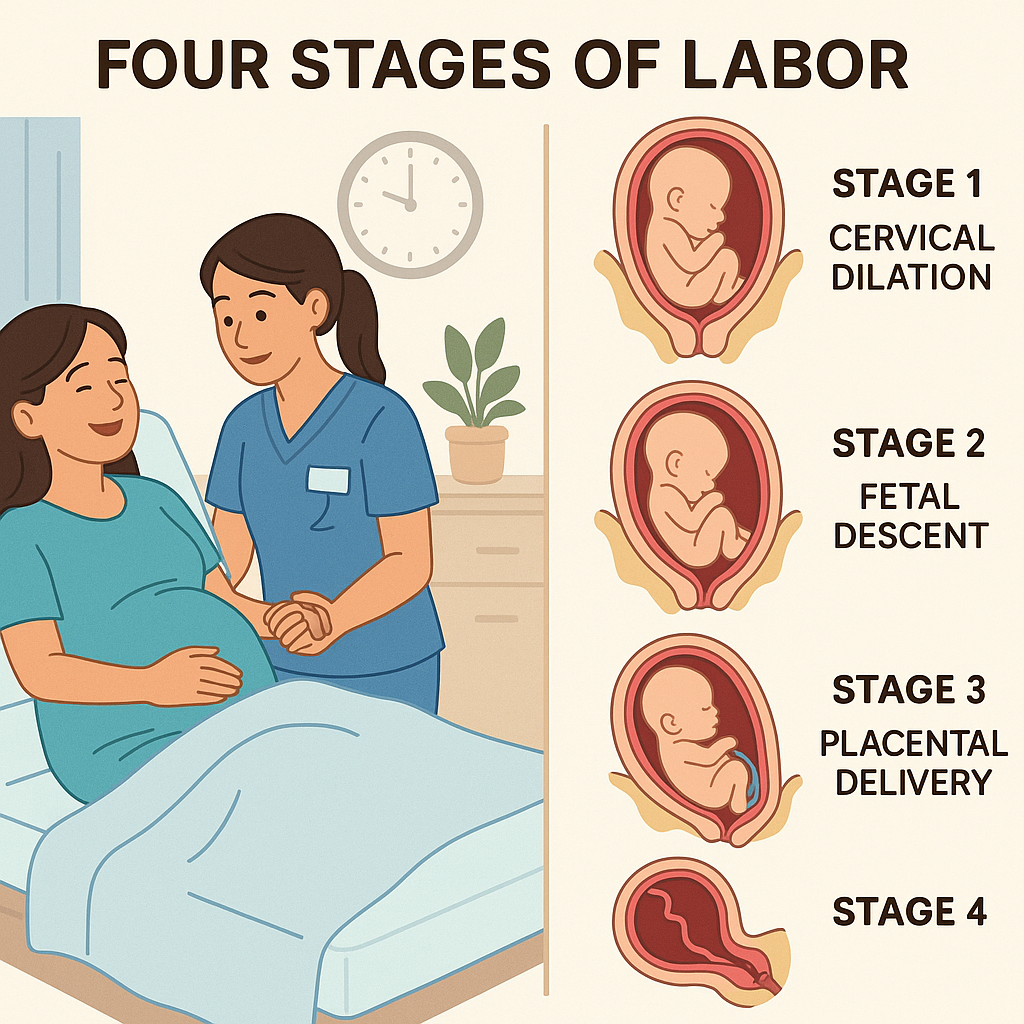Every registered nurse (RN nurse) should understand the stages of labor, especially when working in obstetrics or preparing for the NCLEX. Although labor may seem complex, breaking it into clear steps makes both assessment and intervention easier. By mastering these stages, nurses can ensure safe, confident care for patients and their families.
🩺 Why Nurses Must Know the Stages of Labor
Labor involves the movement of the baby, placenta, and membranes from the uterus. Because of this, nurses must continuously assess progress, recognize complications, and educate patients about what to expect. Furthermore, these competencies are frequently tested on the NCLEX. By understanding each stage in depth, nurses can respond quickly to emergencies and prevent adverse outcomes.
🟢 Stage 1: Dilation Stage
The first stage begins with regular contractions and ends once the cervix reaches full dilation (10 cm). It is divided into three distinct phases:
✅ Latent Phase (0–3 cm)
During this phase, contractions remain mild, and most mothers stay talkative and calm. At this point, nurses should offer reassurance, encourage hydration, and explain the labor process clearly to reduce anxiety.
✅ Active Phase (4–7 cm)
As contractions grow stronger and more frequent, discomfort rises. To help manage this, focus on pain relief, provide emotional support, and perform frequent assessments to monitor labor progress.
✅ Transition Phase (8–10 cm)
When contractions become intense, mothers may experience an overwhelming urge to push and increased irritability. During this phase, maintaining a calm environment and guiding breathing techniques become critical. Remaining present and supportive helps mothers stay focused through this challenging period.
🟡 Stage 2: Expulsion Stage
In the second stage, the baby is delivered. Typically, contractions remain strong, and the duration varies—often shorter for multigravida patients. Effective nursing care involves teaching proper pushing techniques and encouraging rest between contractions to conserve energy. Additionally, involving family members for emotional support can lower maternal stress levels. Continuous fetal heart rate monitoring is also crucial during this time.
👉 NCLEX tip: A prolonged second stage increases the risk of fetal distress, so nurses must act promptly to prevent complications.
🟣 Stage 3: Placental Stage
Once the baby is born, the placenta separates and is expelled. Mild contractions assist with this process, while a small gush of blood usually signals placental separation. At this point, nurses should observe for excessive bleeding, verify placental completeness, and perform fundal massage if prescribed. Moreover, explaining the process to the family can ease anxiety and create a sense of reassurance.
🟠 Stage 4: Recovery Stage
The recovery stage includes the first 1–2 hours following placental delivery. During this crucial period, the mother undergoes significant physical and emotional adjustments. The uterus continues to contract, and the risk of postpartum hemorrhage is highest. Therefore, frequent assessment of vital signs, fundal firmness, and lochia is necessary. In addition, ongoing pain control and emotional reassurance remain key responsibilities for the RN nurse.
👉 NCLEX reminder: A firm, midline fundus indicates normal contraction. Conversely, a soft or deviated fundus signals the need for immediate nursing intervention.
🩹 Tips for Nursing Students
To retain this information effectively:
- Memorize all four stages of labor in sequence.
- Review each phase of Stage 1 carefully.
- Connect every stage with its specific nursing interventions.
- Always prioritize safety by monitoring bleeding, fetal distress, and pain levels.
- Include these notes in your nursing bundle for faster NCLEX review.
📝 Quick Nursing Bundle Cheat Sheet
- Four stages of labor summarized
- Cervical dilation ranges
- Fetal heart rate monitoring points
- Labor comfort measures
- Early signs of postpartum hemorrhage
🩷 Final Thoughts
Understanding the stages of labor empowers nurses to deliver safe and compassionate care throughout childbirth. For those studying for the NCLEX or completing a nursing bundle, mastering these stages ensures stronger clinical judgment and higher exam success. Ultimately, every registered nurse who understands labor stages contributes to safer deliveries and healthier outcomes for mothers and babies.

